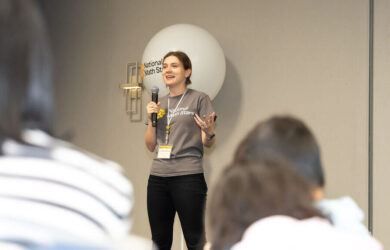
New study co-first-authored by Jerelle Joseph sheds light on how changes in ionic salt transform the way proteins interact
The ability of different types of interactions to act as non-specific modulators of protein phase separation has important implications for how we develop therapies for aberrant condensates.
Jerelle Joseph et al
Like the British Library with its 170 million specimens, the interior of a cell contains a myriad of different proteins and other biomolecules that need to be carefully catalogued in order for the cell to function correctly.
Apart from the nucleus and other well-known cellular compartments that catalogue groups of proteins by enclosing them with membranes, the most common form of compartments found inside cells are membraneless.
These so-called biomolecular condensates are protein-rich liquid drops that remain segregated in space simply by the physics of phase separation – analogous to the separation of oil and water into distinct liquid phases. Liquid–liquid phase separation confers a huge advantage to these compartments over their membrane-bound analogues: the cell can dynamically trigger their formation and dissolution on demand by changing its environment, for instance, the temperature.
A new paper, co-first-authored by Gates Cambridge alumna Jerelle Joseph and published online today in Nature Communications, investigates how changes in salt concentration transform the way proteins interact with one another, making condensates stable or triggering their dissolution.
The paper, “Reentrant liquid condensate phase of proteins is stabilised by hydrophobic and non-ionic interactions”, by Krainer, Welsh, and Joseph et al., is based on a collaboration between experimentalists and computational scientists at the Knowles Lab (University of Cambridge), the Alberti Lab (TU Dresden), the Collepardo Lab (University of Cambridge), the Hyman Lab (Max Planck Institute of Molecular Cell Biology and Genetics) and the St George-Hyslop Lab (University of Cambridge and University of Toronto).
The researchers found that several proteins can form condensates under both low and high salt conditions and can therefore exhibit reentrant phase separation behaviour. However, the molecular interactions driving the phase transition in the low- and high-salt regime are fundamentally different. Whereas hydrophobic and electrostatic interactions are both important at low salt, in the high salt regime the condensate compartments are sustained predominantly by hydrophobic and non-ionic interactions.
The authors state: “Interestingly, many of the proteins we study are implicated in neurodegenerative diseases and cancer. The ability of different types of interactions to act as non-specific modulators of protein phase separation has important implications for how we develop therapies for aberrant condensates. Another hypothesis stemming from our work is that, in the origin of life, the high salt concentrations of oceans could have facilitated the formation of protocells via protein phase separation to keep selected biomolecules phase separated.”
Jerelle [2014], did a PhD in Chemistry and is now a research fellow at King’s College (Cambridge) and the postdoc in the Collepardo Lab.
*The picture shows reentrant phase separation behaviour












